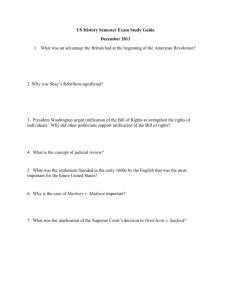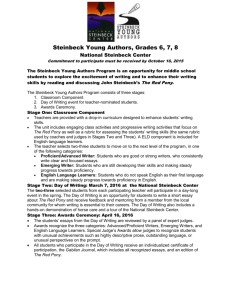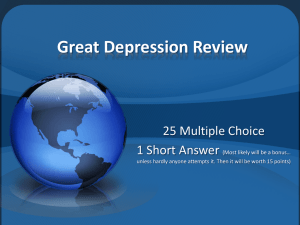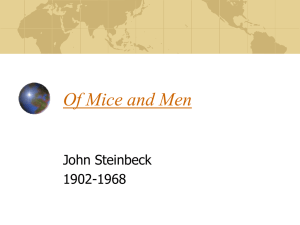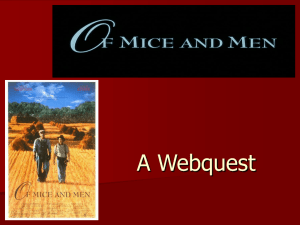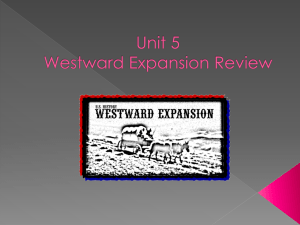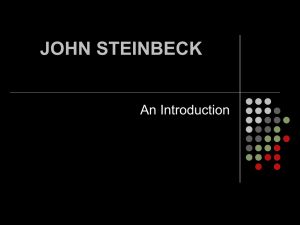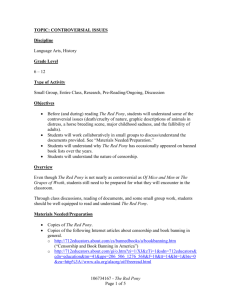as a Word Document
advertisement
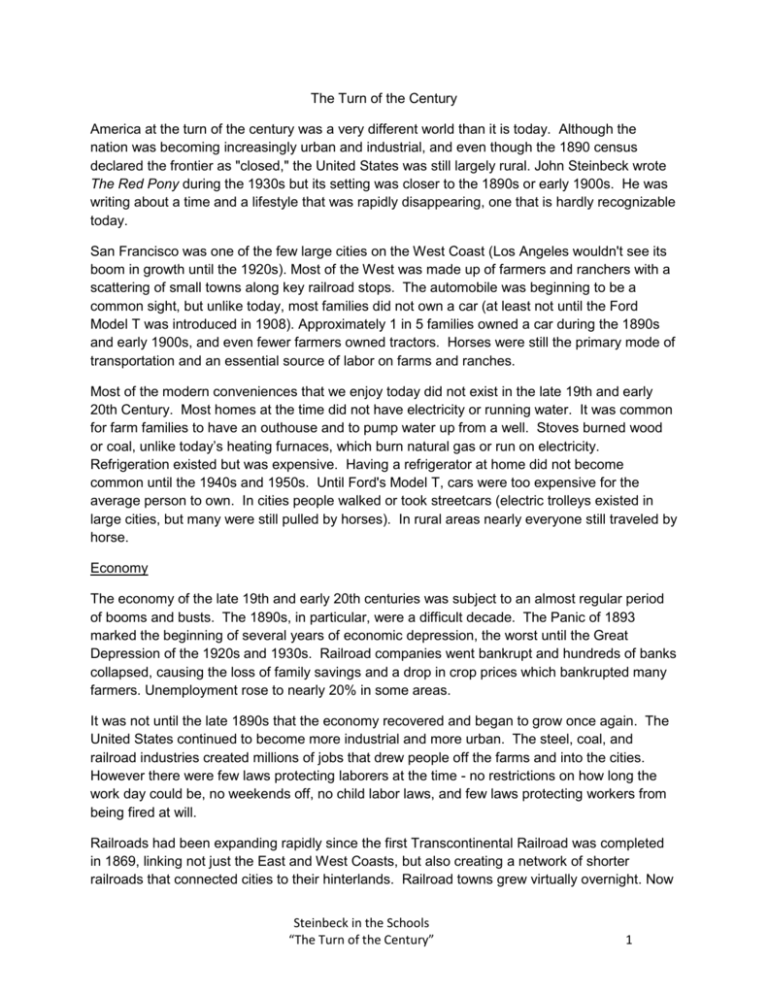
The Turn of the Century America at the turn of the century was a very different world than it is today. Although the nation was becoming increasingly urban and industrial, and even though the 1890 census declared the frontier as "closed," the United States was still largely rural. John Steinbeck wrote The Red Pony during the 1930s but its setting was closer to the 1890s or early 1900s. He was writing about a time and a lifestyle that was rapidly disappearing, one that is hardly recognizable today. San Francisco was one of the few large cities on the West Coast (Los Angeles wouldn't see its boom in growth until the 1920s). Most of the West was made up of farmers and ranchers with a scattering of small towns along key railroad stops. The automobile was beginning to be a common sight, but unlike today, most families did not own a car (at least not until the Ford Model T was introduced in 1908). Approximately 1 in 5 families owned a car during the 1890s and early 1900s, and even fewer farmers owned tractors. Horses were still the primary mode of transportation and an essential source of labor on farms and ranches. Most of the modern conveniences that we enjoy today did not exist in the late 19th and early 20th Century. Most homes at the time did not have electricity or running water. It was common for farm families to have an outhouse and to pump water up from a well. Stoves burned wood or coal, unlike today’s heating furnaces, which burn natural gas or run on electricity. Refrigeration existed but was expensive. Having a refrigerator at home did not become common until the 1940s and 1950s. Until Ford's Model T, cars were too expensive for the average person to own. In cities people walked or took streetcars (electric trolleys existed in large cities, but many were still pulled by horses). In rural areas nearly everyone still traveled by horse. Economy The economy of the late 19th and early 20th centuries was subject to an almost regular period of booms and busts. The 1890s, in particular, were a difficult decade. The Panic of 1893 marked the beginning of several years of economic depression, the worst until the Great Depression of the 1920s and 1930s. Railroad companies went bankrupt and hundreds of banks collapsed, causing the loss of family savings and a drop in crop prices which bankrupted many farmers. Unemployment rose to nearly 20% in some areas. It was not until the late 1890s that the economy recovered and began to grow once again. The United States continued to become more industrial and more urban. The steel, coal, and railroad industries created millions of jobs that drew people off the farms and into the cities. However there were few laws protecting laborers at the time - no restrictions on how long the work day could be, no weekends off, no child labor laws, and few laws protecting workers from being fired at will. Railroads had been expanding rapidly since the first Transcontinental Railroad was completed in 1869, linking not just the East and West Coasts, but also creating a network of shorter railroads that connected cities to their hinterlands. Railroad towns grew virtually overnight. Now Steinbeck in the Schools “The Turn of the Century” 1 farmers could work land much farther away from the large urban centers; they only needed to transport their crops to the nearest town with a rail stop, not all the way to a large city. Farmers and ranchers like the Tiflin family in The Red Pony could work the land in the Salinas Valley to feed the demands of San Francisco over 100 miles away. California and the West The Gold Rush brought hundreds of thousands of people to California between 1848 and 1855 After the Rush, however, people continued to move to California and the West by the thousands. Some came for other rushes, like the Silver Rush in Nevada in 1858. Most of all, people continued to come West for the same reason that Americans had been Westering since they first settled on the East Coast: opportunity. California and the West became the focus of the American Dream. Land was cheap, available, and "anyone" could make it big. The West, however, was not truly open. Expanding westward brought Americans like Jody's grandfather into contact with Native Americans. Until recently, westward expansion was portrayed as courageous pioneers fighting the elements and Indians – the civilized world clashing against the savage world. The historian Patricia Nelson Limerick broke away from this traditional mold to show the history of American westward expansion as one of conquest and violence, not just heroic pioneers. After the war with Mexico (1846-1848), the United States and Mexico signed the Treaty of Guadalupe Hidalgo. In this treaty the United States completed its vision of Manifest Destiny, of a country that spread from the Atlantic coast to the Pacific coast. The present day states of California, Arizona, New Mexico, Nevada, and parts of Colorado and Utah became part of the United States following the treaty with Mexico (the border between Texas and Mexico was finally agreed upon as well). Any Mexican citizens were allowed to become American citizens and to keep the rights to their land. Gitano (The Red Pony, "The Great Mountains") is from one of these families. It was very common for those old "paisano" families, more correctly called Californíos, to lose their land to squatters or to long court battles. White, American families and corporations would then take over the land. International/Diplolmatic/Immigration? Immigrants from Asia and the Pacific continued to come to the United States, arriving in the West where most of them remained. Many came for the Gold Rush, but many more came and stayed for economic opportunities. These immigrants, many from China, were treated poorly after they arrived. Those who tried to make it rich during the Gold Rush found that mining laws did not protect them; in fact, many laws specifically prevented Chinese immigrants and Native Americans from owning mining claims. Asian immigrants and Native Americans also faced violence and lynching in the mining towns of the West. Immigration continued, however, long after the Gold Rush. Ethnic neighborhoods popped up in cities and towns (Chinatown, Japantown, Little Italy, etc.). These sections of towns and cities were both a haven for immigrants as well as a prison. However, it was a place to learn the language and to do business relatively safely. Steinbeck gives a glimpse of such an area and Steinbeck in the Schools “The Turn of the Century” 2 hints at the attitudes towards Chinese immigrants in several of his stories, particularly the character Lee in East of Eden (also see "Johnny Bear" in The Long Valley). The late 19th and early 20th Century was a time of global expansion for the United States. Swiftly the nation was becoming a strong force abroad. Industrial and agricultural growth helped to feed and fuel westward expansion within the United States, but it also made the United States an important exporter to Europe. Not heeding the advice of George Washington's Farewell Address, the United States became more and more entangled economically and militarily with Europe. In an incident sparked by the explosion and sinking of The Maine, an American steamship, in the Cuban harbor at Guantanamo Bay, the United States went to war with Spain. Yellow journalism from newspapers, particularly papers owned by William Randolph Hearst, helped to fan the flames of war and whip up public support in the United States. The Maine, which as history has shown sank when a steam boiler exploded by accident, was portrayed as an intentional attack by Spain, one which required vengeance by the United States. Spain was portrayed as an oppressive empire whose subjects the United States should fight to set free. War with Spain lasted from April to August of 1898. At the end of the war, Cuba had been freed from Spain and the United States took control of the Philippine Islands, Puerto Rico, and Guam. Many people from these areas were able to immigrant more easily to the United States as a result, often finding work as agricultural laborers in California. Social Steinbeck's characters were a product of the times during which he wrote and was writing about. Steinbeck is often, however, criticized for his portrayal of women in his stories and novels. The only female character the reader meets in Of Mice and Men has no name; in The Red Pony, Jody's mother rarely appears outside of the kitchen; in East of Eden, Cannery Row, and Of Mice and Men female characters are often portrayed or spoken of only in reference to prostitution. Many critics, however, believe that Steinbeck was describing the world as it was, not defining a place for women that he thought was proper. Steinbeck was writing during a time when Women's rights were still being established. The Red Pony and East of Eden take place prior to the ratification of the 19th Amendment (1920) giving women the right to vote. Women worked outside the home doing jobs that were seen as "women's work," but even this was usually looked down upon. This was also the time of Jim Crow laws and lynchings. In 1896 the Supreme Court decided in the case Plessy v. Ferguson, that segregation was legal as long as African Americans, and other non-white minorities, had "separate but equal" facilities of their own - a ruling which specifically targeted African Americans. Schools, theaters, train cars, and more were segregated; there was a "whites only" and a "colored" section. In many parts of the country African Americans were not allowed to speak in court nor allowed to sue whites. And when the laws oppressing African Americans did not seem like enough, lynchings took the lives of thousands and thousands of Africans Americans. Steinbeck in the Schools “The Turn of the Century” 3
